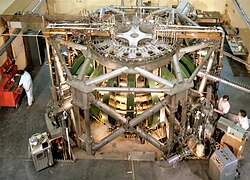Our website is made possible by displaying online advertisements to our visitors.
Please consider supporting us by disabling your ad blocker.
Princeton Large Torus
| Princeton Large Torus | |
|---|---|
 The PLT in 1975. Toroidal coils are visible in green. | |
| Device type | Tokamak |
| Location | Princeton, New Jersey, United States |
| Affiliation | Princeton Plasma Physics Laboratory |
| Technical specifications | |
| Major radius | 1.32 m (4 ft 4 in) |
| Minor radius | 0.4 m (1 ft 4 in) |
| Magnetic field | 4 T (40,000 G) |
| Heating power | 5 MW (ICRH) 3 MW (NBI) 1 MW (LH) |
| Plasma current | 700 kA |
| History | |
| Date(s) of construction | 1972[1] |
| Year(s) of operation | 1975–1986 |
| Preceded by | Symmetrical Tokamak (ST) |
| Succeeded by | Tokamak Fusion Test Reactor (TFTR) |
| Related devices | Adiabatic Toroidal Compressor (ATC) |
The Princeton Large Torus (or PLT), was an early tokamak built at the Princeton Plasma Physics Laboratory (PPPL). It was one of the first large scale tokamak machines and among the most powerful in terms of current and magnetic fields. Originally built to demonstrate that larger devices would have better confinement times, it was later modified to perform heating of the plasma fuel, a requirement of any practical fusion power device.
The tokamak became a topic of serious discussion in 1968, when the Soviets published new data showing them to be far better than any other fusion device. This generated significant skepticism among other researchers and it was some time before the PPPL was convinced to convert their Model C stellarator to the tokamak configuration. It immediately validated the Soviet results and then surpassed them. The next step in developing the system would be to build a larger machine to test whether the confinement time of the plasma scaled as expected. PLT was designed to not only be larger, but also have dramatically higher internal plasma currents on the order of 1 MA.[2]: 214
Another problem with the tokamak approach is that it does not directly heat its fuel to the required temperatures over 50 million Kelvin. Around the time that PLT was being built, Oak Ridge National Laboratory had successfully introduced the neutral beam injection heating concept, or NBI. NBI was added to PLT and it began setting record after record, eventually reaching 75 million K, well beyond the minimum needed for a practical fusion device. Its success was a matter of some controversy within the newly formed Department of Energy (DOE), who was at the same time looking to cut the fusion budget. This resulted in what was known as "the PLT weekend" when the press learned of the success and the DOE attempted to downplay it.
PLT's success led the way for plans to build an even larger machine capable of reaching breakeven, a long-sought goal in fusion power. This system emerged as the Tokamak Fusion Test Reactor, or TFTR. Originally slated to be built at Oak Ridge, PLT's success led to it winning the TFTR contest as well.
- ^ Heitzenroeder, Phil; Meade, Dale (5 October 2018). "History of Mechanical Engineering for Fusion Research at Princeton" (PDF).
- ^ Fusion: The Energy of the Universe
Previous Page Next Page


